Fokker 50 Video - Picture
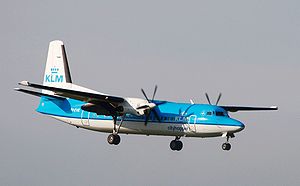
|
|
Fokker 50
Fokker 50 / Fokker 60

Picture - Fokker 50
Role: Airliner
Manufacturer: Fokker
First flight: 28 December 1985
Introduced: 1987
Status: Operational
Primary users: VLM Airlines
KLM Cityhopper
Air Baltic
Avianca
Produced: 1987 - 1997
Number built: 213
Developed from: Fokker F27
The Fokker 50 is a turboprop-powered airliner, designed as a refinement of and successor to the highly successful Fokker F27 Friendship. The Fokker 60 is a stretched freighter version of the Fokker 50. Both aircraft were built by Fokker in the Netherlands. The Fokker 60 has also been used by the Royal Netherlands Air Force and now they are in service with the Peruvian Naval Aviation.
Development
Fokker 50
The Fokker 50 was designed after sales of the Fokker F27 Friendship, which had been in continual production since 1958, were beginning to decline by the 1980s. Fokker management, notably Frans Swarttouw, decided that aircraft with aerodynamic and avionics updates, derived from both the Fokker F27 and the Fokker F28 were sensible. Design of the Fokker 50 started in 1983, with DLT and Ansett Airlines of Australia being launch customers.

Picture - A Palestinian Airlines Fokker at El Arish International Airport.
Fokker built two prototypes derived from F27 airframes, the first of which flew for the first time on 28 December 1985. Certification of the Fokker 50 by the Dutch aviation authority RLD was successfully completed in 1987 and the first production aircraft was delivered to DLT of Germany. Production ended in 1996 after the Fokker Aircraft Company went into liquidation, with the last aircraft delivered the following year. By the end of the program, 213 Fokker 50s had been produced. As of August 2006 a total of 171 Fokker 50 aircraft remain in airline service. Major operators include: Malaysia Airlines (10) (now operated by Maswings and Firefly), Denim Air (12), Skyways Express (18) and VLM Airlines (20). Some 27 other airlines also operate smaller numbers of the type.
Fokker 60
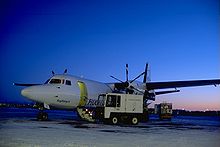
Picture - An Air Iceland Fokker 50 in Reykjavik
The Fokker 60 is stretched 1.62 m (5.31 ft) longer than the F50 for a total length of 26.87 m (88.16 ft). It has a large cargo door on the right side immediately behind the cockpit. Only four examples were built, all of them delivered to the Royal Netherlands Air Force. All of them were part of 334 Squadron based at Eindhoven airbase (EIN/EHEH). They were used to transport equipment and soldiers. Paradrops were done as well. Another 60 were under construction but never completed, due to Fokker's bankruptcy. Two of the Fokker 60s (U-01, U-03) were converted in 2005 to Maritime Patrol aircraft as a temporary solution when the Royal Netherlands Navy P-3 Orions were phased out due to budget cuts. They were stationed at Hato AB Curax§ao, until they were replaced by civil DHC-8 aircraft in October 2007. When the Royal Netherlands Air Force decided to buy two extra Lockheed C-130s, the Fokker 60s were phased out. The four Fokker 60 that were stored at Woensdrecht Air Base were sold to the Peruvian Naval Aviation, the first two planes were delivered on June 8th, 2010 and the second batch of two planes is estimated to be delivered by the end of 2010.
Design
The Fokker 50 was based on the stretched F27-500 airframe, but with a larger number of smaller windows in the fuselage and a two-wheel nose gear.
Basic construction of the fuselage, wings and empennage (tail) remained unchanged apart from strengthening the various sections where required. The wing was equipped with upturned ailerons and wingtips, effectively acting as wing endplates or winglets.
The major design change from the Fokker F27 was in the engines, and in equipping the aircraft with an electronic flight and engine-management system. The original Rolls-Royce Darts in various marks of basically 1,268-1715 kW (1,700-2,300 hp) was replaced with two more fuel efficient Pratt & Whitney Canada PW124 powerplants of 1,864 kW (2,500 hp) each, driving six-bladed Dowty Rotol propellers.
The Fokker 50 can carry up to 62 passengers over a range of 2,000 km (1,243 mi, 1,080 nmi) at a typical speed of 530 km/h (329 mph, 286 kn), a 50 km/h (31 mph, 27 kn) increase over the Fokker F27.
Variants
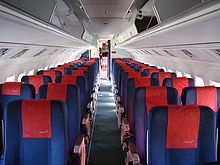
Picture - Interior of a Fokker 50 of Skyways Express
Fokker 50
F27 Mark 050
Marketed as the Fokker 50 (or sometimes referred to as the Fokker 50-100), based on the F27 Mark 500 with two Pratt & Whitney Canada PW125B or PW127B turboprop engines with six-bladed propellers, updated systems and cockpit instrumentations, increased use of composite structure, double the number of windows, change from pneumatic to hydraulic systems and addition of an electronic engine and propeller controls and electronic flight instrument system (EFIS) and integrated warning system.
F27 Mark 0502
Marketed as the Fokker 50, same as the 050 with reconfigured interior layout and change in type of aft emergency exits, six built (two for the Royal Netherlands Air Force, two for the Singapore Air Force and two for Brunei).
Fokker 60
F27 Mark 0604
Marketed as the Fokker 60, same as the 0502 with an increased fuselage length (1.02 m/3.34 ft in front of wing and 0.80 m/2.63 ft aft of wing), increased design weight and introduction of a large cargo door in the forward right side of the fuselage. Two Pratt & Whitney PW127B turboprop engines, four built.
Operators
As of August 2009 168 aircraft are still in operational use with airlines.
Fokker 50 civil operators
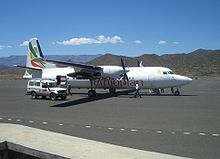
Picture - Fokker 50 - Ethiopian Airlines at Lalibela airport
Aero Condor
Aero Mongolia
Air Astana
Air Baltic
Air Iceland
Alliance Airlines
Amapola Flyg
Aria Air
Avianca
Blue Bird Aviation
CityJet
Compagnie Africaine D'Aviation
Denim Air
Ethiopian Airlines
Feeder Airlines
Flyfirefly
Independent Aviation
Indonesia Air Transport
Iranian Air Transport
Kish Airline
Luxair
Mid Airlines
Miniliner
Nova Airlines
Pakistan International Airlines
Palestinian Airlines
Riau Airlines
SAS Norge
Skyways Express
Skywest Airlines
Sonair
Sudan Airways
Taftan Air
VLM Airlines
Fokker 50 military and government operators
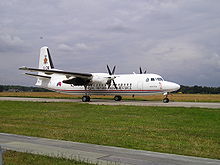
Picture - Fokker 50 - Royal Netherlands Air Force
The following governments or military operators currently fly the Fokker 50 in passenger or cargo roles:
Netherlands
Royal Netherlands Air Force.
Republic of China
Republic of China Air Force - as VIP transport.
Singapore
Republic of Singapore Air Force - as Utility Transport Aircraft (UTA) and Maritime Patrol Aircraft (MPA).
Former operators
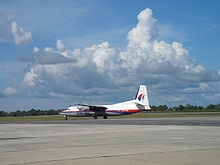
Picture - Regional services were flown by Malaysia Airlines using Fokker 50s until the takeover by FlyAsianXpress and subsequently MASwings
Australia
Airlines of New South Wales
Ansett Australia
Flight West Airlines
Austria
Austrian Airlines/Tyrolean Airways
Brazil
Nordeste Linhas Aéreas Regionais
Rio Sul
TAM Airlines
Estonia
Estonian Air
Germany
Lufthansa CityLine
Contact Air
India
Rajair
Kenya
Kenya Airways
Luxembourg
Luxair
Malaysia
Firefly
FlyAsianXpress
Malaysia Airlines
MASwings
Netherlands
KLM Cityhopper
Nigeria
Virgin Nigeria Airways
Norway
Norwegian Air Shuttle
Philippines
Philippine Airlines
Spain
Iberia/Air Nostrum
Taiwan
Formosa Airlines/Mandarin Airlines
United Kingdom
Air UK
Fokker 60 Military Operators
Peru
Peruvian Naval Aviation - 2 as Utility Transport Aircraft (UTA) and 2 as Maritime Patrol Aircraft (MPA).
Former Operators
Netherlands
Royal Netherlands Air Force.
Specifications
Fokker 50 series 100
Data from airlines.net
General characteristics
Crew: 2 (pilot & co-pilot)
Capacity: Up to 58 passengers
Length: 25.25 m (82 ft 10 in)
Wingspan: 29.00 m (95 ft 2 in)
Height: 8.32 m (27 ft 4 in)
Wing area: 70.0 m² (736 ft²)
Empty weight: 12,250 kg (27,602 lb)
Loaded weight: 18,600 kg (41,000 lb)
Max takeoff weight: 20,820 kg (45,900 lb)
Powerplant: 2x— Pratt & Whitney Canada PW125B turboprops, 3,864 kW (4,500 hp) each
Performance
Cruise speed: 453 km/h (245 kn , 282 mph)
Range: 2,055 km (1,110 nmi, 1,284 mi)
Service ceiling: 7,620 m (25,000 ft)
Armament
2 x— AGM-84D Harpoon missiles and radar, sonar systems (Republic of Singapore Air Force Fokker 50s)
Fokker 60
Data from airlines.net
General characteristics
Crew: 2 (pilot & co-pilot)
Length: 26.87 m (88 ft 2 in)
Wingspan: 29.00 m (95 ft 2 in)
Height: 8.32 m (27 ft 4 in)
Wing area: 70.0 m² (736 ft²)
Max takeoff weight: 22,950 kg (50,595 lb)
Powerplant: 2x— Pratt & Whitney Canada PW127B turboprops, 4,050 kW (6,750 hp) each
Performance
Cruise speed: 632 km/h (387 kn, 391 mph)
Related development
Fokker F27
Fairchild Hiller FH-227
Comparable aircraft
Antonov An-140
ATR 42 and 72
CASA CN-235 and EADS CASA C-295
de Havilland Canada Dash 8
Embraer EMB 120 Brasilia
Fairchild-Dornier 328 family
Ilyushin Il-114
Saab 2000 and 340
Xian MA60/Xian Y-7/Antonov An-24
European Aviation Safety Agency Type-Certificate Data Sheet - Fokker F27 (TCDS A.036 Issue 2 20 May 2005)
Fokker 50 Pictures
More aircraft.
Source: WikiPedia